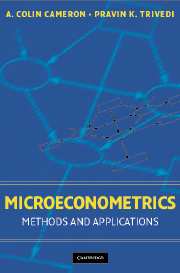 A. Colin Cameron and Pravin
K. Trivedi
A. Colin Cameron and Pravin
K. Trivedi
MICROECONOMETRICS: Methods and Applications
Cambridge University Press, New York
May 2005
PART 2 (chapters 4-10)
Part 2 presents the core methods – least squares, method of moments, and
maximum likelihood -- of estimation and inference in nonlinear regression
models that are central in microeconometrics. Both the traditional
topics as well as more modern topics like quantile regression, sequential
estimation, empirical likelihood, bootstrap, and semi- and nonparametric
regression are covered. In general the discussion is at a level intended
to provide enough background and detail to enable the practitioner to read
and comprehend articles in the leading econometrics journals. We presume
prior familiarity with linear regression analysis.
Chapter 4 begins with the linear regression model. It then covers at an introductory
level quantile regression, which models distributional features other than
the conditional mean. It provides a lengthy expository treatment of instrumental
variables estimation, a major semiparametric method of causal inference.
Chapter 5 presents the most commonly-used estimation methods for nonlinear
models, beginning with the quite general topic of m-estimation, before
specialization to maximum likelihood and nonlinear least squares regression.
Chapter 6 provides a comprehensive treatment of generalized method of moments,
which is a quite general estimation framework, applicable both in linear
and nonlinear, and single- and multi-equation settings. The chapter emphasizes
the special case of instrumental variables estimation.
Chapter 7 covers both the classical and bootstrap approaches to hypothesis
testing, while Chapter 8 presents relatively more modern methods of model
selection and specification analysis. .Because of their importance the bootstrap
methods also get a more detailed stand-alone treatment in Chapter
11. As much as possible testing methods are presented in a unified manner
in these chapters, but specific applications occur throughout the book
Chapter 9 is a stand-alone chapter that presents nonparametric and semiparametric
estimation methods that place a flexible structure on the econometric model.
Chapter 10 presents the computational methods used to compute the nonlinear
estimators presented in chapters 5 and 6. This material becomes especially
relevant to the practitioner if an estimator is not automatically computed
by an econometrics package.
Back to Main Page
 A. Colin Cameron and Pravin
K. Trivedi
A. Colin Cameron and Pravin
K. Trivedi